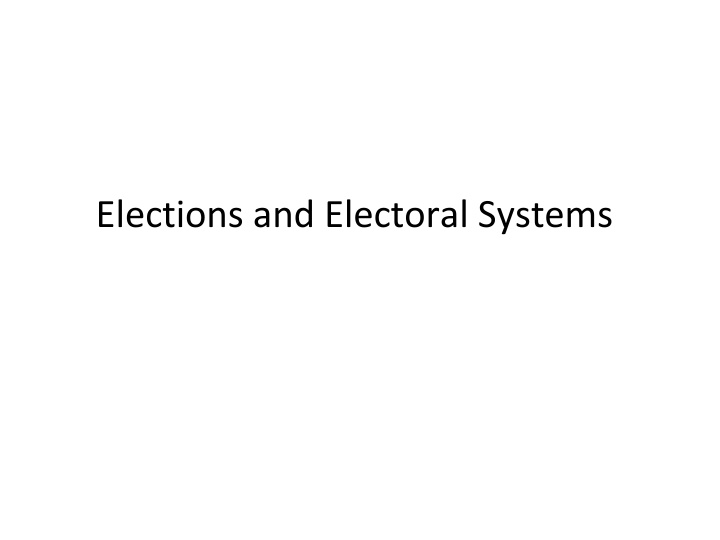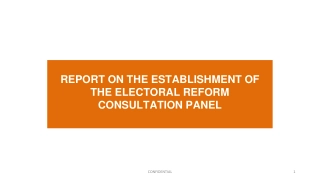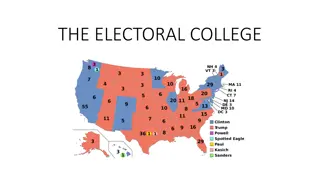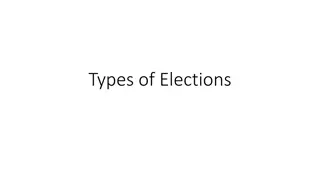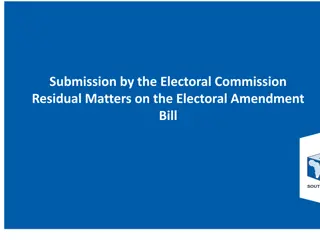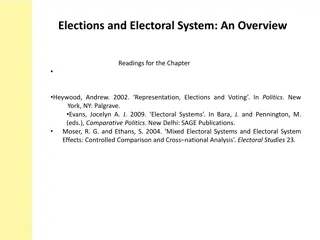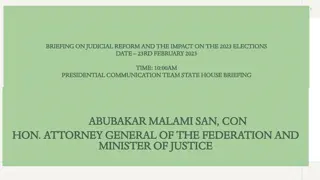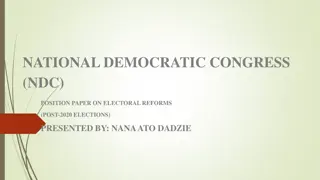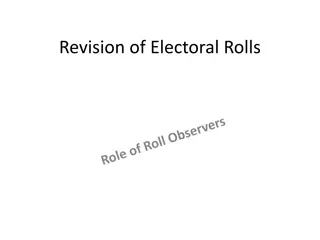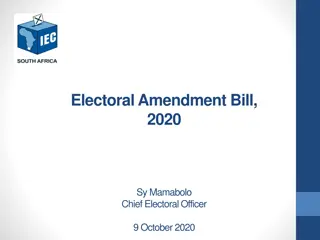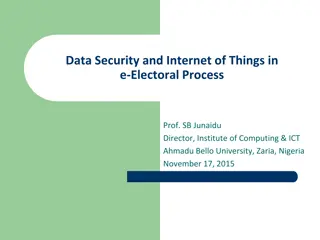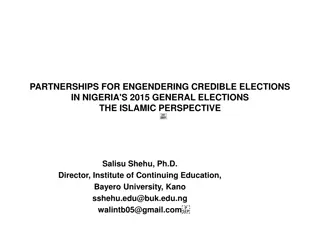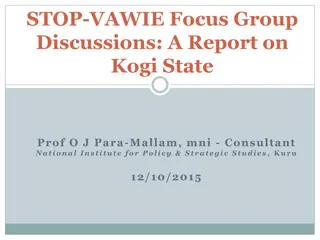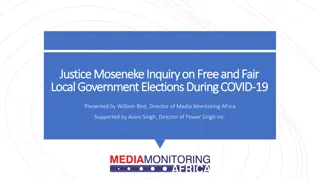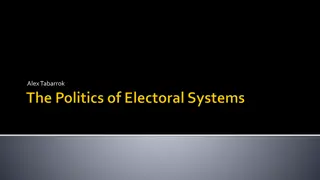Elections and Electoral Systems
Delve into the intricacies of elections and electoral systems, exploring their significance, functionality, and impact on governance. Gain insights into the principles that underpin democratic processes and the diverse methods used worldwide to elect representatives and leaders.
Download Presentation

Please find below an Image/Link to download the presentation.
The content on the website is provided AS IS for your information and personal use only. It may not be sold, licensed, or shared on other websites without obtaining consent from the author.If you encounter any issues during the download, it is possible that the publisher has removed the file from their server.
You are allowed to download the files provided on this website for personal or commercial use, subject to the condition that they are used lawfully. All files are the property of their respective owners.
The content on the website is provided AS IS for your information and personal use only. It may not be sold, licensed, or shared on other websites without obtaining consent from the author.
E N D
Presentation Transcript
Democracies are sometimes classified in terms of their electoral system. An electoral system is a set of laws that regulate electoral competition between candidates or parties or both.
Elections are increasingly used to fill legislative and executive offices around the world. Almost all of the world s independent states today use direct elections to elect people to their lower house of parliament.
Legislative and Presidential Elections by Decade 350 300 250 Number of Elections 200 150 100 50 0 1950s 1960s 1970s 1980s 1990s 2000s 2010s Presidential Legislative
Electoral integrity refers to the extent to which the conduct of elections meets international standards and global norms concerning good elections. These norms and standards are usually set out in treaties, conventions, and guidelines issued by international and regional organizations.
Violations of electoral integrity are referred to as electoral malpractice.
Very High High Moderate Low Very Low Not Assessed Electoral Integrity, 2021
South Korea United States PEI Index PEI Index Electoral Authorities Electoral Authorities Laws Laws Procedures Procedures Results Results Count Boundaries Count Boundaries 20 20 40 40 Voter Registration Voter Registration 60 60 Voting Voting 80 80 100 100 Party Registration Party Registration Finance Finance Media Media Egypt Belarus PEI Index PEI Index Electoral Authorities Laws Electoral Authorities Laws Procedures Results Procedures Results Count Boundaries Count Boundaries 20 20 40 40 Voter Registration Voter Registration 60 60 Voting Voting 80 80 100 Finance 100 Party Registration Party Registration Finance Media Media
Democracies tend to have higher levels of electoral integrity than dictatorships. There s variation, though, among both democracies and dictatorships.
Electoral integrity is influenced by: Domestic structural constraints The role of the international community Institutional design Electoral management bodies
Two strategies to identify election fraud: 1. Election monitoring 2. Election forensics
Benfords Law: Frequency Distribution of First and Second Digits 0 1 2 3 4 5 6 7 8 9 MEAN E 0.301 0.176 0.125 0.097 0.079 0.067 0.058 0.051 0.046 3.441 0.120 0.114 0.109 0.104 0.100 0.097 0.093 0.090 0.088 0.085 4.187
Political scientists typically distinguish between electoral systems based on their electoral formula. 1. Majoritarian 2. Proportional 3. Mixed An electoral formula determines how votes are translated into seats.
Electoral System Families Electoral System Families Proportional Mixed Majoritarian Single Transferable Vote Dependent Independent List PR Plurality Absolute Majority Correction Conditional Alternative Vote TRS: Majority-Runoff Single-Member District Plurality Single Nontransferable Vote Block Vote Party Block Vote Borda Count Modified Borda Count Limited Vote TRS: Majority-Plurality Coexistence Supposition Fusion Divisor Quota Hare d Hondt Sainte-Lagu Modified Sainte-Lagu Hagenbach-Bischoff Droop Imperiali Reinforced Imperiali
A majoritarian electoral system is one in which the candidates or parties that receive the most votes wins.
A single-member district plurality system (SMDP) is one in which individuals cast a single vote for a candidate in a single-member district. The candidate with the most votes wins.
Bedford Constituency, UK Legislative Elections, 2019 CANDIDATE PARTY VOTES PERCENTAGE MOHAMMAD YASIN LABOUR 20,491 43.3 RYAN HENSON CONSERVATIVE 20,346 43.0 HENRY VANN LIBERAL DEMOCRAT 4,608 9.7 ADRIAN SPURRELL GREEN 960 2.0 CHARLES BUNKER BREXIT 896 1.9
The single nontransferable vote (SNTV) is a system in which voters cast a single candidate-centered vote in a multimember district. The candidates with the highest number of votes are elected.
Whereas SMDP and SNTV are plurality majoritarian electoral systems, the alternative vote is an absolute majority majoritarian system. The alternative vote (AV), sometimes called the instant-runoff vote, is a candidate-centered preference voting system used in single-member districts where voters rank order the candidates.
If a candidate wins an absolute majority of first-preference votes, they re immediately elected. If no candidate wins an absolute majority, the candidate with the fewest first-preference votes is eliminated, and their votes are reallocated among the remaining candidates based on the designated second preferences. This process is repeated until one candidate has obtained an absolute majority of the votes cast (full preferential system) or an absolute majority of the valid votes remaining (optional preferential system).
Richmond Constituency, New South Wales, Australia 1990 SECOND COUNT FOURTH COUNT SEVENTH COUNT FIRST COUNT THIRD COUNT FIFTH COUNT SIXTH COUNT CANDIDATE (NO.) (%) (NO.) (%) (NO.) (%) (NO.) (%) (NO.) (%) (NO.) (%) (NO.) (%) STAN GIBBS 4,346 6.3 4,380 6.3 4,420 6.4 4,504 6.5 4,683 6.8 NEVILLE NEWELL 18,423 26.7 18,467 26.7 18,484 26.8 18,544 26.9 18,683 27.1 20,238 29.4 34,664 50.5 GAVIN BAILLIE 187 0.3 ALAN SIMS 1,032 1.5 1,053 1.5 1,059 1.5 1,116 1.6 IAN PATERSON 445 0.6 480 0.7 530 0.8 DUDLEY LEGGETT 279 0.4 294 0.4 CHARLES BLUNT 28,257 40.9 28,274 41.0 28,303 41.0 28,416 41.2 28,978 42 29,778 43.2 33,980 49.5 HELEN CALDICOTT 16,072 23.3 16,091 23.3 16,237 23.5 16,438 23.8 16,658 24.1 18,903 27.4
Australian How-To-Vote Card, Green Party, Canning Constituency, 2015
The majority-runoff two-round system (TRS) is another absolute majority majoritarian electoral system.
In a majority-runoff TRS voters cast a single candidate-centered vote in a single-member district. Any candidate who obtains an absolute majority in the first round of elections is elected. If no one obtains an absolute majority, then the top two vote winners go on to compete in a runoff election in the second round.
Burundi Presidential Elections, 2020 FIRST ROUND CANDIDATE PARTY VOTE SHARE (%) VARISTE NDAYISHIMIYE CNDD-FDD 71.45 AGATHON RWASA NATIONAL CONGRESS FOR LIBERTY 25.15 GASTON SINDIMWO UNION FOR NATIONAL PROGRESS 1.70 DOMITIEN NDAYIZEYE KIRA BURUNDI COALITION 0.57 L ONCE NGENDAKUMANA FRONT FOR DEMOCRACY IN BURUNDI 0.49 DIEUDONN HAHIMANA INDEPENDENT 0.43 FRANCIS ROHERO INDEPENDENT 0.21
Uruguay Presidential Elections, 2019 FIRST ROUND CANDIDATE PARTY VOTE SHARE (%) DANIEL MARTINEZ BROAD FRONT 40.49 LUIS ALBERTO LACALLE POU NATIONAL PARTY 29.70 ERNESTO TALVI COLORADA PARTY 12.80 GUIDO MANINI R OS OPEN CABILDO 11.46 PARTIDO ECOLOGISTA RADICAL INTRANSIGENTE C SAR VEGA 1.43 EDGARDO NOVICK PARTIDO DE LA GENTE 1.12 PABLO MIERES INDEPENDENT PARTY 1.01 GONZALO ABELLA POPULAR UNITY 0.84 GUSTAVO SALLE GREEN ANIMALIST PARTY 0.83 OTHERS 0.33 SECOND ROUND DANIEL MARTINEZ BROAD FRONT 49.21 LUIS ALBERTO LACALLE POU NATIONAL PARTY 50.79
A proportional, or proportional representation (PR), electoral system is a quota- or divisor-based electoral system employed in multimember districts. The rationale behind PR systems is to produce a proportional translation of votes into seats.
Proportional representation (PR) electoral systems come in two main types: 1. List proportional representation systems (List PR) 2. Single transferable vote (STV)
In a list PR system, each party presents a list of candidates to voters in each multimember district. Parties receive seats in proportion to their overall share of the votes. These seats are then allocated among the candidates on their list.
List PR systems differ in important ways: 1. The precise formula for allocating seats to parties 2. The district magnitude 3. The use of electoral thresholds 4. The type of party list employed
All PR systems employ either quotas or divisors to allocate seats to parties.
A quota is essentially the price in terms of votes that a party must pay to guarantee themselves a seat in a particular electoral district.
A quota, Q(n), is calculated as Vd Q(n) = Md + n Vd is the number of valid votes in district d. Md is the district magnitude or number of available seats in district d. n is the modifier of the quota.
Vd Q(n) = Md + n Hare quota: n = 0. Hagenbach-Bischoff quota: n = 1. Imperiali quota: n = 2. Reinforced imperiali quota: n = 3. The Droop quota is the Hagenbach-Bischoff quota plus 1.
Allocating Seats to Parties using the Hare Quota PARTY A PARTY B PARTY C PARTY D PARTY E PARTY F TOTAL VOTES 47,000 16,000 15,800 12,000 6,100 3,100 100,000 SEATS 10 QUOTA 10,000 VOTES QUOTA 4.7 1.6 1.58 1.2 0.61 0.31 AUTOMATIC SEATS 4 1 1 1 0 0 7 REMAINDER SEATS 3
Allocating Seats to Parties using the Hare Quota PARTY A PARTY B PARTY C PARTY D PARTY E PARTY F TOTAL VOTES 47,000 16,000 15,800 12,000 6,100 3,100 100,000 SEATS 10 QUOTA 10,000 VOTES QUOTA 4.7 1.6 1.58 1.2 0.61 0.31 AUTOMATIC SEATS 4 1 1 1 0 0 7 REMAINDER SEATS 3 What about the remainder seats?
The most common method for allocating the remainder seats is the largest remainder method. Hare Quota with Largest Remainders PARTY A PARTY B PARTY C PARTY D PARTY E PARTY F TOTAL VOTES 47,000 16,000 15,800 12,000 6,100 3,100 100,000 SEATS 10 QUOTA 10,000 VOTES QUOTA 4.7 1.6 1.58 1.2 0.61 0.31 AUTOMATIC SEATS 4 1 1 1 0 0 7 REMAINDER 0.7 0.6 0.58 0.2 0.61 0.31 REMAINDER SEATS 1 1 0 0 1 0 3 TOTALSEATS 5 2 1 1 1 0 10
A divisor, or highest average, system divides the total number of votes won by each party in a district by a series of numbers (divisors) to obtain quotients. District seats are then allocated according to which parties have the highest quotients.
The three most common divisor systems are: D Hondt: 1, 2, 3, 4, . . . Sainte-Lagu : 1, 3, 5, 7, . . . Modified Sainte-Lagu : 1.4, 3, 5, 7, . . .
Allocating Seats to Parties using the dHondt Divisor System PARTY A PARTY B PARTY C PARTY D PARTY E PARTY F TOTAL VOTES 47,000 16,000 15,800 12,000 6,100 3,100 100,000 SEATS 10 47,000 (1) 16,000 (3) 15,800 (4) 12,000 (6) 6,100 3,100 VOTES 1 23,500 (2) 8,000 (9) 7,900 (10) 6,000 3,050 1,550 VOTES 2 15,666 (5) 5,333 5,266 4,000 2,033 1,033 VOTES 3 11,750 (7) 4,000 3,950 3,000 1,525 775 VOTES 4 9,400 (8) 3,200 3,160 2,400 1,220 620 VOTES 5 7,833 2,667 2,633 2,000 1,017 517 VOTES 6 TOTAL SEATS 5 2 2 1 0 0 10
The key factor influencing the proportionality of an electoral system is the district magnitude. District magnitude refers to the number of representatives elected in a district. The larger the district magnitude, the greater the degree of proportionality.
Theres considerable variation in district magnitude across countries. In 2006 and 2007, Ukraine had a district magnitude of 450. Serbia currently has a district magnitude of 250. Historically, Chile had a district magnitude of 2.
All proportional electoral systems have an electoral threshold. An electoral threshold is the minimum level of support a party needs to obtain representation.
A natural threshold is a mathematical by-product of the electoral system. A formal threshold is explicitly written into the electoral law. Electoral system proportionality is low when the electoral threshold is high.
Electoral thresholds can have negative side-effects. In Turkey 2002, so many parties failed to surpass the 10% threshold that fully 46% of all votes were wasted. In Poland 1993, 34% of the votes were wasted, allowing the former Communists to return to power.
In a closed party list, the order of candidates elected is determined by the party itself, and voters aren t able to express a preference for a particular candidate. In an open party list, voters can indicate not just their preferred party, but also their favored candidate within that party. In a free party list, voters have multiple votes they can allocate either within a single party list or across different party lists.
